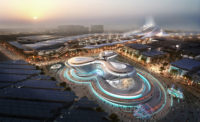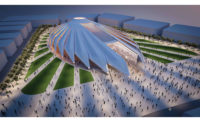Dubai Expo’s Fantastical National Pavilions

Dubai Expo 2020 walkway designating thematic districts and directing visitors to various national pavilions. Photo © Roland Halbe

The UAE pavilion’s carbon fiber wings are inspired by the national bird, the falcon, designed by Santiago Calatrava. Photo © Roland Halbe

Side view of the UAE Pavilion with vantage of projection dome designed by Adrian Smith + Gordon Gill Architecture at The Al Wasl Plaza (meaning “connection”), the heart of the expo. Photo © Roland Halbe

The Saudi Arabia Pavilion, designed by Boris Micka. Photo © Roland Halbe

Saudi Arabia Pavilion’s interior showcasing five of the kingdom’s natural landscapes. Photo © Roland Halbe

The UK pavilion exterior (timber-laminated slats with LED-lit words) “Poem Pavillion”, designed by Es Devlin Studio. Photo © Roland Halbe

Singapore green-focused “Nature, Nurture, Future” Pavilion by WOHA architects. Photo © Roland Halbe

The curved, luminescent Pakistan pavilion by Al Jabal Engineering. Photo © Roland Halbe








The United Arab Emirate’s futuristic World Exposition, Dubai Expo 2020, opened in October following eight years of planning and a yearlong delay due to the coronavirus pandemic. The sixth month exhibition, and Middle East’s first World Fair, features pavilions of over 190 countries, designed by world-renowned architects. Dubai’s arid 1,080-acre site in its South District includes architectural feats like Asif Khan’s carbon-fiber entryways and Adrian Smith + Gordon Gill Architect’s 425-foot-diameter trellised steel dome that doubles as the world’s largest 360° projection screen in the heart of Al Wasl Plaza. Titled “Connecting Minds Creating the Future,” the Dubai Expo expects 25 million visitors and incorporates districts of three themes: sustainability, opportunity, mobility.

Spain Pavilion’s sustainably-focused “solar chimneys”, designed by Amann-Cánovas-Maruri. Photo © Roland Halbe
Its national pavilions include a broad swath of subjects, materials, and forms, from Singapore’s floral-gallery-cum-botanist-laboratory to the U.S. SpaceX Falcon9 rocket replica. The UAE’s falcon-inspired, solar-panel-clad structure by Santiago Calatrava boasts operable wings of carbon fiber.The prong-like facade of the UK’s “Innovating for a Shared Future” by Es Devlin Studio consists of cross-laminated timber slats laced with LED-illuminated poems in English and Arabic, which explore the country’s diversity through artificial intelligence and interactive messaging. A sinuous edifice, with a luminescent vibrantly-colored exterior, constitutes Pakistan's installation-filled pavilion by Al Jabal Engineering that reflects the country’s seasonal change and spiritual traditions.

The interior of the Spanish pavilion, made of natural, sustainable materials such as fabric and wood. Photo © Roland Halbe
Much of Dubai Expo 2020 aims to take a sustainability-centered approach. A highlight of the exhibition is Spain’s conical “solar chimneys” of reusable materials like fabric, wood, and iron, by Amann-Cánovas-Maruri, which point to possibilities for sustainable design. Saudi Arabia’s LEED-platinum, six-story sloped rectangle by Boris Micka, entitled “Heritage”, confers access to the kingdom’s five natural ecosystems, where visitors can interactively learn about the country’s rich history and culture. Another nature-centered national pavilion is Singapore’s “Nature, Nurture, Future”, which resembles an overgrown treehouse replete with plant and tech-informed microclimate. The verdant pavilion by WOHA architects demonstrates the potential for sustainable urban solutions that integrate engineering, technology, and nature.
While the exposition has been lauded for its impressive pavilions, critics have also decried construction fatalities and its use of low-paid foreign labor – a stark contrast to its seven billion dollar budget. The World Expo, which last appeared in Milan in 2015, is expected to run until March 31, 2022.




